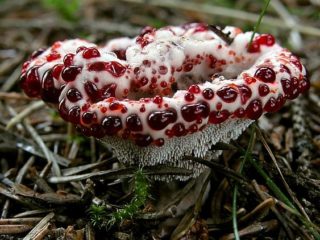Content
Ileodictyon graceful is a saprophyte mushroom belonging to the class Agaricomycetes, family Veselkovy, genus Ileodictyon. Other names: white basketweed, graceful clathrus, white clathrus.
Where do Ileodictyon graceful grow?
White basketgrass is common in the Southern Hemisphere. In Australia and New Zealand it is one of the most commonly found fungi. As a result of population migration, it came to America, Africa (Burundi, Ghana), the Pacific Islands, and Europe (Portugal).
White clathrus grows in colonies and singly in forests on soil and litter or on cultivated lands.Throughout the year it is found in the tropics and subtropics of the Australian continent, Africa, Europe, Japan, Samoa, and the island of Tasmania.
What do Ileodictyons graceful look like?
Ileodictyon graceful resembles a white cage or wire-like ball that can detach from its base and roll around like a tumbleweed plant. The cellular structure looks very elegant, which corresponds to the name.
First, like all representatives of the Vespers, it is a white spherical egg covered with a leathery shell, about 3 cm in diameter, with strands of mycelium. The ball seems to “explode”, forming four petals. From it emerges a rounded fruiting body of complex shape with a checkered structure, consisting mainly of pentagonal cells, the number of which reaches 30. The diameter of the ball ranges from 4 to 20 cm. The bridges of this cell are slightly thickened and smooth. Their diameter is about 5 mm. At the intersection points you can see noticeable thickenings. The inner surface is covered with olive or olive-brown mucus with spores. For some time, the broken egg is held at the base of the fruiting body, and when the cellular structure matures, it can come off.
Mature white basketwort has an unpleasant odor (like sour milk), which is described as foul.
The spores of the fungus have the shape of a narrow ellipse. They are thin-walled, smooth, transparent, colorless. The size reaches 4-6 x 2-2.4 microns. Basidia (fruiting structures) are 15-25 x 5-6 microns. Cystids (elements of the hymenium that protect the basidium from damage) are absent.
Is it possible to eat ileodictyons?
White clathrus is considered a mushroom suitable for consumption and belongs to the category of conditionally edible specimens.
Nothing is known about the taste of the mushroom.
False doubles
The closest relative of Clathrus elegans, which in all its characteristics is very similar to it, is Ileodictyon edible. The main differences are a larger cage and thicker bars. It grows in colonies or singly in forests and cultivated areas (meadows, fields, lawns). One of the few mushrooms that can break away from their base and move and roll.
Ileodictyon edible is especially common in New Zealand and Australia, and was introduced to Africa and the UK. Its fruiting bodies are found throughout the year in the tropics and subtropics.
Despite the extremely unpleasant smell of a mature mushroom, it is considered edible when it is in the egg stage. Ileodictyon edible is believed to have medicinal properties. There is no information about its taste.
Conclusion
Ileodictyon graceful is widespread in the Southern Hemisphere, but is almost unknown in Russia. It is famous for its unique structure, reminiscent of a wire spherical cell; in the mature stage it has an extremely unpleasant odor.










